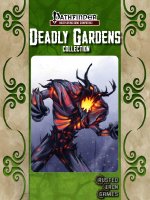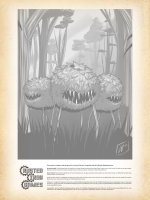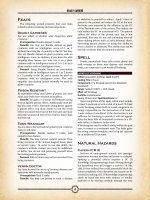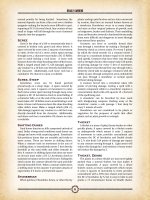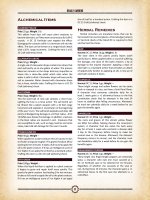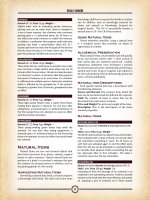d eadly g ardens collection 5
Bạn đang xem bản rút gọn của tài liệu. Xem và tải ngay bản đầy đủ của tài liệu tại đây (85.98 KB, 1 trang )
Deadly Gardens
with a DC 18 Acrobatics check.
the surface layer of soil is on the verge of collapse.
The ground above an uncollapsed sinkhole will often
be slightly depressed. A sinkhole can be identified
and avoided with a DC 18 Knowledge (nature) check.
Walking across an uncollapsed sinkhole will cause
it to collapse, dropping anyone in the area (10 foot
square) down 20 feet to the bottom of the sinkhole
causing 2d6 falling damage. A DC 20 Reflex save
avoids falling in the collapsing sinkhole.
Patch of Deathcaps (CR 2)
A patch of small, black mushrooms that grow
in damp soil or on a wet rock surface. A patch of
deathcaps can be identified with a DC 16 Knowledge
(dungeoneering) check. If the patch of deathcaps
(10 ft. x 10 ft.) is disturbed, due to rough handling
or a creature walking on them for example, it will
release a burst of negative energy (2d6 negative
energy damage, 30 ft. radius, DC 14 Will save reduces
the damage by half). A patch of deathcaps can only
release one such burst every 24 hours. Deathcaps
only grow underground or in similar dark places.
Larger patches of deathcaps release 1d6 negative
energy for every two 5 foot squares that they cover.
Terrain Types
Kudzu
Kudzu is a type of rapidly growing vine that quickly
spreads to cover all available space often choking out
other types of plants. Moving into a space covered
with Kudzu vines is difficult, costing 2 squares of
movement. At the beginning of each move action to
move through Kudzu a character must make a DC 13
Acrobatics check or become entangled in the clinging
vines. Characters entangled in Kudzu cannot move
out of that space until they spend a standard action
to free themselves. Small or smaller creatures gain
concealment while in an area covered in Kudzu.
Quagmire (CR2)
A quagmire is an area of sucking mud that will pull
creatures down into its depths. These muddy areas
appear deceptively solid. A creature approaching
a quagmire makes a DC 12 Survival check to spot
the hazard. Creatures running or charging are not
allowed to make this check. Quagmires are typically
about 20 feet in diameter. The momentum of a
running or charging creature carries it 1d2x5 feet
into the Quagmire. A creature entering a quagmire
becomes entangled and cannot move while it
remains entangled. As a standard action a creature
may attempt a DC 15 Strength or Escape Artist
check to free itself. A creature unable to free itself
will slowing sink into the quagmire. After 2 minutes
the creature will be completely under the mud. The
creature is then considered helpless and may not take
any actions except for holding its breath and waiting
to be rescued. To rescue a completely submerged
creature takes a DC 20 Strength check.
Razor Shale
Razor shale is a type of rock usually found in
arid badlands and rocky desert environments. The
stone gains its name from its tendency to break off
in large flakes that leave sharp edges of exposed
rock. Climbing a wall or cliff of razor shale can be
a dangerous proposition. Climbing a natural wall
of razor shale requires a DC 30 Climb check. Any
creature climbing razor shale must also succeed at a
DC 30 Reflex save or take 1d6 slashing damage from
the sharp edges of the stone.
Using a rope to help climb a razor shale wall
gives a +10 circumstance bonus on the Climb check.
Additionally when using a rope to climb a razor shale
surface, a failed climb check will cause the rope to
take 1d4 slashing damage.
Rockslide (CR4)
When rocks or boulders are perched on the side
of a hill or mountain there is the chance they could
come crashing down. Anyone caught in the area
of a rockslide is subject to battering by the falling
rocks (Atk +15, 4d6 damage). Anyone struck by the
attack must make a DC 15 Reflex save to avoid being
knocked prone and possibly trapped in the debris.
The chance of being trapped is 20% plus the amount
of damage taken. A trapped character can free herself
with a DC 25 Strength check or her companions can
spend several (1d10) minutes digging them out.
Salt Flats
Salt flats are formed when standing water from
a marsh or lake evaporates, leaving behind an area
of flat ground covered with deposits of salt and
other minerals. In sunlight, or other bright lighting
conditions, the mineral deposits reflect the light,
shining a bright white. Creatures in the area are
dazzled (-1 on attack rolls and -1 on sight based
Perception checks). Creatures with light blindness
or light sensitivity take a -2 on attack rolls and -2
on sight based Perception checks instead of the
Sinkhole (CR 1)
A sinkhole is a hidden void in the ground where
5
